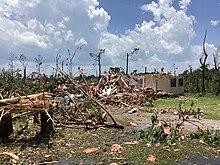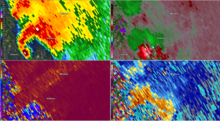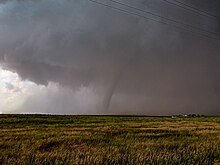Tornadoes of 2023
Most Atlantic tropical cyclones missed the United States during the peak of hurricane season, with few early-season frontal systems; an intense outbreak in December produced 18 tornadoes, causing seven fatalities.In early January, a three-day severe-weather outbreak brought damaging winds, large hail, and a number of tornadoes to the Southern United States and impacted the Midwest to a lesser extent.A third large, long-tracked EF2 tornado damaged or destroyed houses, vehicles, and a mobile home in Montrose, Arkansas, and snapped or uprooted many trees and power poles along its path.In Louisiana, another EF2 tornado struck the small community of Gaytine, where houses had their roofs torn off, a mobile home was destroyed, a metal building was heavily damaged, and a fifth-wheel RV trailer was flipped.They included a high-end EF2 tornado that struck southeastern Norman, severely damaging homes and businesses, destroying self-storage units, overturning cars, and injuring 12 people.The storm system moved into the Ohio Valley on March 3, where an EF2 tornado in the small community of Fremont, Kentucky destroyed outbuildings, heavily damaged a church, and tore the roofs off several homes.The first high risk area covered southeastern Iowa, northwestern Illinois, and far northeastern Missouri, while the second included eastern Arkansas, southwestern Tennessee, and northern Mississippi.[71] Anticipated severe weather in the Eastern United States on April 6 resulted in the New York Mets, Baltimore Orioles, and Philadelphia Phillies postponing their home opening games.[75] A linear complex of severe thunderstorms with embedded circulations developed in Missouri and moved eastward through the St. Louis metro area on April 15, producing multiple tornadoes.A strong EF2 tornado destroyed an outbuilding near Vichy, Missouri, heavily damaged metal airplane hangars at Rolla National Airport, and injured five people.Another EF1 tornado struck Belleville, Illinois, where homes, apartment buildings, and businesses had roofing blown off and large trees snapped or uprooted; some fell on structures.They included two large EF2 tornadoes that passed near Uehling and Lyons, destroying numerous barns, garages, grain bins, and farm buildings and damaging several homes.A low-end EF2 tornado near North Bend damaged or destroyed grain bins and outbuildings, flipped irrigation pivot sprinklers, and shifted a house slightly off its foundation.A large, multiple-vortex wedge tornado near Greeley and Spalding flipped and bent irrigation pivots, blew out the windows of two vehicles, scoured gravel off a dirt road, and damaged trees and power poles.[4] A high-end EF1 tornado struck Laguna Heights, Texas early on the morning of May 13, where numerous poorly-built mobile homes were heavily damaged or destroyed, and a man inside one of them was killed.[122] Severe weather also continued to impact the Gulf Coast and the Southeast later that night into the early morning of June 16, where many instances of damaging winds, large hail and isolated tornadoes were reported.Later that night, a destructive EF3 tornado near Louin, Mississippi, severely damaged or destroyed numerous homes and industrial buildings, flipped vehicles, flattened large swaths of trees, killed one person, and injured 25 others.[128] In late June, multiple rounds of significant tornadic activity swept across the Great Plains, Mississippi Valley, the Southeastern and Northeastern United States, Manitoba and Ontario the day after the previous outbreak sequence came to an end.The tornado exited Dortches and continued to the east-northeast, destroying a house, significantly damaging numerous other homes, and flattening a metal truss electrical transmission tower.[151] After law enforcement reported that up to 50,000 pallets of medicine had been damaged at the Pfizer facility, Erin Fox of University of Utah Health stated that there could be shortages of certain drugs while the company dealt with the situation.[162] Flooding created standing water along the Grand Central Parkway and Long Island Expressway in Queens, with ground stops at LaGuardia and Newark Liberty International Airports.[163] A severe weather and tornado outbreak occurred across parts of the Great Lakes and southwestern Ontario during the evening of August 24, including the Grand Rapids and Webberville, Michigan, areas and Metro Detroit.In the early morning hours of October 12, a waterspout offshore of Clearwater Beach moved northeast and made landfall in Dunedin, partially tearing the roof off of an apartment building and earning a low-end EF2 rating.[187][189] The second tornado struck areas near the small villages of Getmold, Lashorst and Hedem along a 5.3 km (3.3 mi)-long path, snapping or uprooting large trees and severely damaging the roofs of multiple homes.[187][191] A strong tornado was caught on video from multiple angles as it impacted areas in and around several small towns and villages in the Nouvelle-Aquitaine region of France on March 9, causing extensive damage.A second F1 tornado struck the village of Tatlıçayır, Diyarbakır Province, where homes had roof damage, a frail masonry outbuilding was destroyed, trees were downed, and farm animals were injured.The tornado collapsed several steel truss electrical transmission towers, toppled large metal light poles and signs, and also destroyed masonry outbuildings.[224][225][226][227] At about 6:10 p.m. on April 21, a strong tornado struck central Myanmar in Leiway Township near the capital city of Naypyidaw, causing major damage and killing several people in the villages of Tada Oo and Aung Myin Kone.[228][229] On April 22, a tornado was caught on video by local residents as it struck Jalan Bani Bu Ali in Ash Sharqiyah South Governorate of eastern Oman.The storm produced a tornado that caused severe damage to homes, buildings, and vehicles in the town of Sede Nova, where numerous trees and power poles were downed as well, and 11 people were injured.


















Yuma, ColoradoCheyenne, OklahomaAdamsville, Tennesseelate-march tornado outbreakRhineland-Palatinatea tornadoRolling Fork, MississippiKeota, IowaDidsbury, Albertatornadoestornado outbreaksUnited StatesArgentinaBrazilBangladeshEast IndiaCanadaNorthern HemisphereEuropeAustraliaNew Zealandsevere weatherthunderstormsIndonesiaMyanmarTurkeySaudi Arabiatornado watchesEuropean Severe Storms LaboratoryDeutscher WetterdienstInternational Fujita scaleStorm CiaránList of United States tornadoes from January to February 2023List of United States tornadoes in March 2023List of United States tornadoes from April to May 2023List of United States tornadoes in June 2023List of United States tornadoes from July to August 2023List of United States tornadoes from September to December 2023Enhanced Fujita ratinglocal storm reportMississippiArkansasIllinoisIllinois, IndianaJonesboro, LouisianaSouthern United StatesMidwestStorm Prediction CenterJessieville, ArkansasMontrose, ArkansasGulf CoastLouisianaAlabamaJordan Lake ReservoirDeatsville, AlabamaDecaturRichland Community CollegeMontgomery, AlabamaRoosterville, GeorgiaSandersvilleCarolinasDeWitt, ArkansasGreenville, KentuckyCane Creek State ParkMemphis, TennesseeJackson, MississippiAmtrakCity of New OrleansMinneapolis-St. Paul International Airportground stopClearwater Township, MinnesotaSouth DakotaTornado outbreak of January 12, 2023NEXRADsoutheastern United StatessupercellEmelleMovico, AlabamaSelma, Alabamatornado emergenciesAutaugaElmoreChiltonTallapoosaOld KingstonGeorgiaLaGrangeGriffinExperimentJenkinsburgJackson LakeAtlantaMabletonTennesseeKentucky2023 Pasadena–Deer Park tornadoSoutheast TexasHouston metropolitan areaPasadenaDeer Parktornado emergencySiennaPearlandOrangefieldOrangeVintonVentressFloridaHoustonOhio ValleyPindall, ArkansasRipley, MississippiWesson, MississippiRamer, TennesseeLewisburgLaGrange, GeorgiaNorthwestern UniversityWest VirginiaCullman, AlabamaFebruary 2023 North American storm complexTexas panhandleMissouriwind shearsquall lineOklahoma City metropolitan areaNorman